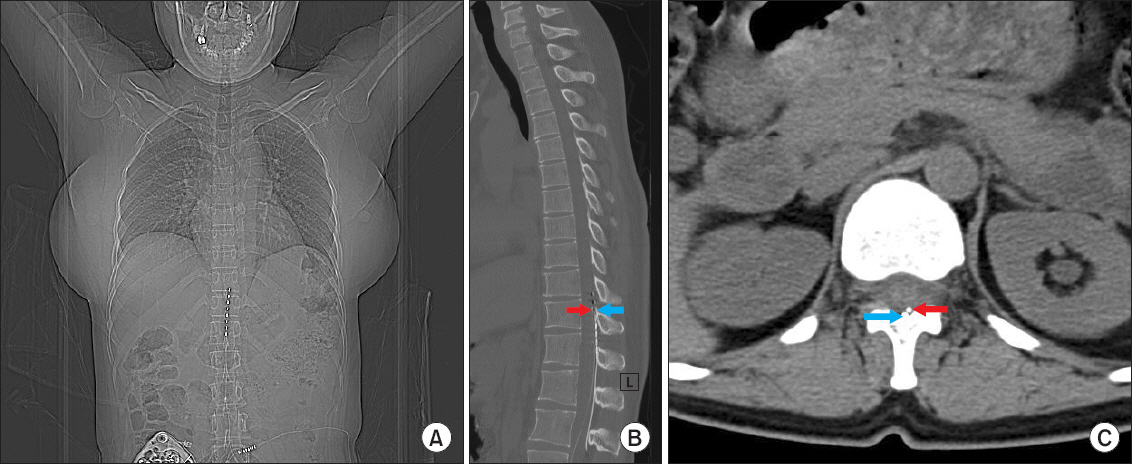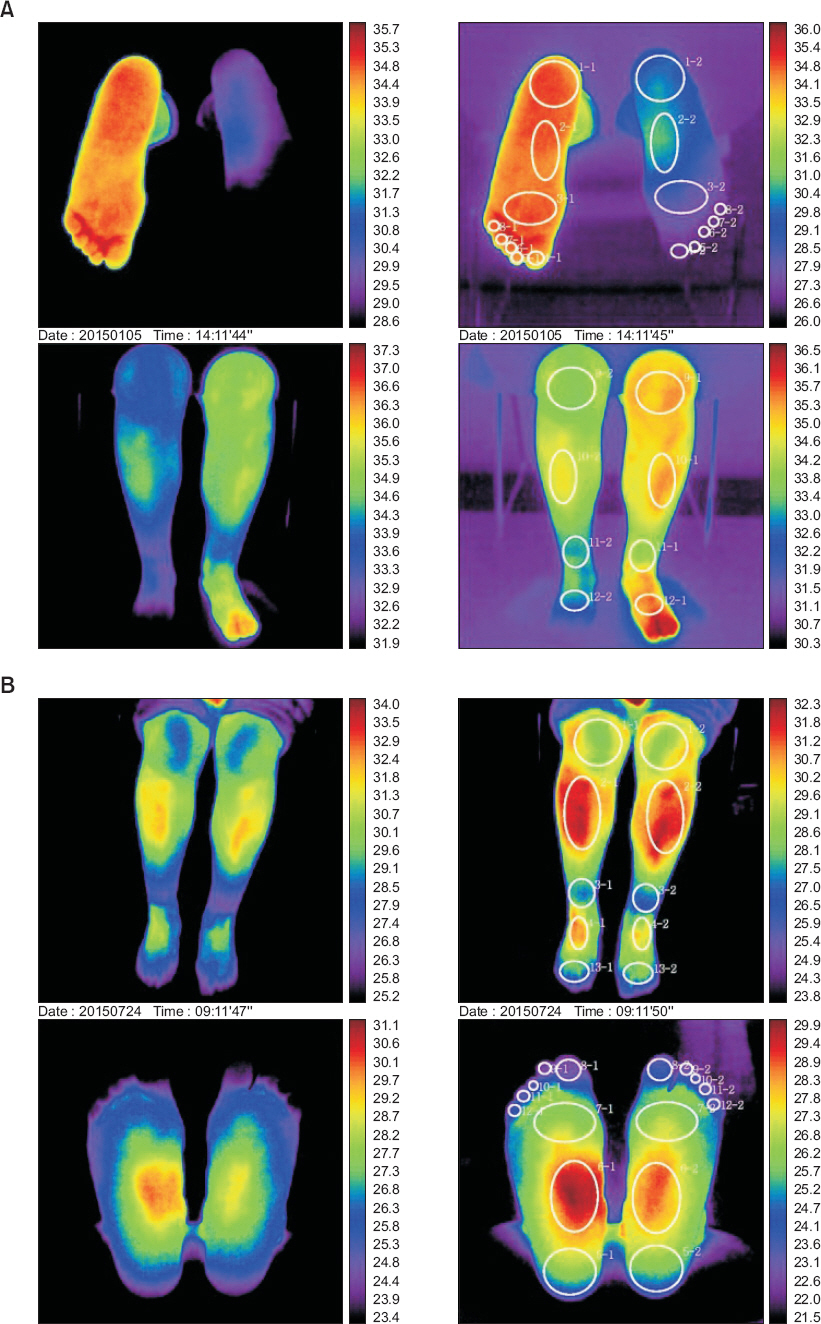Anesth Pain Med.
2018 Apr;13(2):201-206. 10.17085/apm.2018.13.2.201.
Intrathecal baclofen pump implantation for complex regional pain syndrome in a patient with a spinal cord stimulator: consideration about optimal location of intrathecal catheter tip: A case report
- Affiliations
-
- 1Department of Anesthesiology and Pain Medicine, Inje University Haeundae Paik Hospital, Busan, Korea. anelse@naver.com
- 2Department of Anesthesiology and Pain Medicine, The Keon Sarang Medical Office, Geoje, Korea.
- 3Department of Anesthesiology and Pain Medicine, Dong Kang Hospital, Ulsan, Korea.
- KMID: 2437430
- DOI: http://doi.org/10.17085/apm.2018.13.2.201
Abstract
- Intrathecal baclofen (ITB) pump implantation can be used to control dystonia and severe pain associated with complex regional pain syndrome (CRPS) with or without a spinal cord stimulator (SCS). A 45-year-old female patient had gotten an SCS to control the pain of CRPS. However, she suffered from chronic intractable pain in her left ankle and foot despite paresthesia in the entire painful area because the effectiveness of the SCS gradually diminished over time. In a trial of intrathecal drug administration, baclofen was superior to morphine for pain relief, had fewer side effects, and was superior in terms of patient satisfaction. To achieve the greatest degree of pain relief from the ITB pump, the tip of the intrathecal catheter was carefully placed in relation to the SCS. Over a one-year follow-up period, the patient experienced mild pain without any adverse effects.
MeSH Terms
Figure
Reference
-
1. Merskey H, Bogduk N. Classification of chronic pain: descriptions of chronic pain syndromes and definitions of pain terms. 2nd ed. Seattle: IASP Press;1994. p. 40–3.2. Wilson PR, Yaksh TL. Baclofen is antinociceptive in the spinal intrathecal space of animals. Eur J Pharmacol. 1978; 51:323–30. DOI: 10.1016/0014-2999(78)90423-5.3. Zuniga RE, Schlicht CR, Abram SE. Intrathecal baclofen is analgesic in patients with chronic pain. Anesthesiology. 2000; 92:876–80. DOI: 10.1097/00000542-200003000-00037. PMID: 10719971.4. Slonimski M, Abram SE, Zuniga RE. Intrathecal baclofen in pain management. Reg Anesth Pain Med. 2004; 29:269–76. DOI: 10.1097/00115550-200405000-00014. DOI: 10.1016/j.rapm.2004.01.005. PMID: 15138913.5. Lind G, Meyerson BA, Winter J, Linderoth B. Intrathecal baclofen as adjuvant therapy to enhance the effect of spinal cord stimulation in neuropathic pain: a pilot study. Eur J Pain. 2004; 8:377–83. DOI: 10.1016/j.ejpain.2003.11.002. PMID: 15207519.6. Marinus J, Moseley GL, Birklein F, Baron R, Maihöfner C, Kingery WS, et al. Clinical features and pathophysiology of complex regional pain syndrome. Lancet Neurol. 2011; 10:637–48. DOI: 10.1016/S1474-4422(11)70106-5.7. Geurts JW, Smits H, Kemler MA, Brunner F, Kessels AG, van Kleef M. Spinal cord stimulation for complex regional pain syndrome type I: a prospective cohort study with long-term follow-up. Neuromodulation. 2013; 16:523–9. DOI: 10.1111/ner.12024. PMID: 23363081.8. Kumar K, Rizvi S, Bnurs SB. Spinal cord stimulation is effective in management of complex regional pain syndrome I: fact or fiction. Neurosurgery. 2011; 69:566–78. DOI: 10.1227/NEU.0b013e3182181e60. PMID: 21441839.9. Hayek SM, Deer TR, Pope JE, Panchal SJ, Patel VB. Intrathecal therapy for cancer and non-cancer pain. Pain Physician. 2011; 14:219–48. PMID: 21587327.10. Penn RD, Kroin JS. Continuous intrathecal baclofen for severe spasticity. Lancet. 1985; 2:125–7. DOI: 10.1016/S0140-6736(85)90228-4.11. van Hilten BJ, van de Beek WJ, Hoff JI, Voormolen JH, Delhaas EM. Intrathecal baclofen for the treatment of dystonia in patients with reflex sympathetic dystrophy. N Engl J Med. 2000; 343:625–30. DOI: 10.1056/NEJM200008313430905. PMID: 10965009.12. van Rijn MA, Munts AG, Marinus J, Voormolen JH, de Boer KS, Teepe-Twiss IM, et al. Intrathecal baclofen for dystonia of complex regional pain syndrome. Pain. 2009; 143:41–7. DOI: 10.1016/j.pain.2009.01.014. PMID: 19232828.13. van der Plas AA, Marinus J, Eldabe S, Buchser E, van Hilten JJ. The lack of efficacy of different infusion rates of intrathecal baclofen in complex regional pain syndrome: a randomized, double-blind, crossover study. Pain Med. 2011; 12:459–65. DOI: 10.1111/j.1526-4637.2011.01065.x. PMID: 21332937.14. Bernards CM. Cerebrospinal fluid and spinal cord distribution of baclofen and bupivacaine during slow intrathecal infusion in pigs. Anesthesiology. 2006; 105:169–78. DOI: 10.1097/00000542-200607000-00027. PMID: 16810009.15. de Jose A, Luciano P, Vicente V, Marcos Juan AS, Gustavo FC. Role of catheter's position for final results in intrathecal drug delivery. Analysis Based on CSF Dynamics and Specific Drugs Profiles. Korean J Pain. 2013; 26:336–46. DOI: 10.3344/kjp.2013.26.4.336. PMID: 24155999. PMCID: PMC3800705.
- Full Text Links
- Actions
-
Cited
- CITED
-
- Close
- Share
- Similar articles
-
- Implantable Intrathecal Drug Delivery Pump in Complex Regional Pain Syndrome Patient : A case report
- A Case of Disappeared Complex Regional Pain Syndrome after Spinal Cord Injury: A case report
- Effects of Intrathecal Baclofen on Spasticity
- Catheter Obstruction of Intrathecal Drug Administration System: A Case Report
- Epidural Granuloma after Intrathecal Pump Implantation in the Spinal Cord: A Case Report



